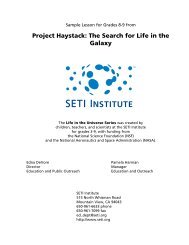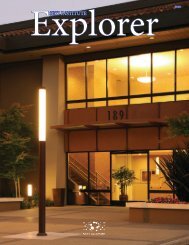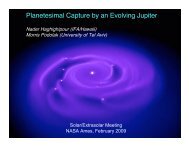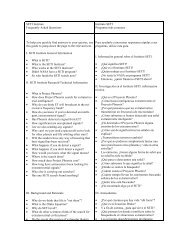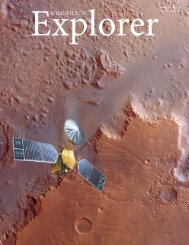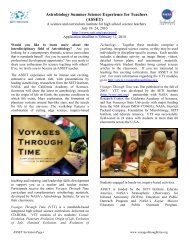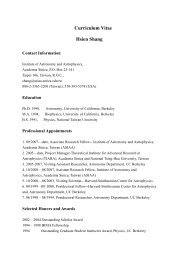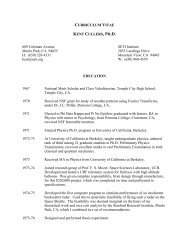Inside the Boardroom with Alan Bagley - SETI Institute
Inside the Boardroom with Alan Bagley - SETI Institute
Inside the Boardroom with Alan Bagley - SETI Institute
Create successful ePaper yourself
Turn your PDF publications into a flip-book with our unique Google optimized e-Paper software.
Of course, a space program – while necessary<br />
– wouldn’t have been sufficient to<br />
forestall <strong>the</strong> dino’s incandescent demise. A<br />
good defense would have required an active<br />
astronomy effort to detect <strong>the</strong> incoming<br />
rock. Physics was essential as well, for<br />
o<strong>the</strong>rwise how could <strong>the</strong>y calculate <strong>the</strong><br />
asteroid’s orbit<br />
This is an all-too-elaborate digression<br />
on a wry joke, but <strong>the</strong>re’s little doubt that<br />
our brains, schooled in science, can insure<br />
us against <strong>the</strong> sort of cosmic catastrophes<br />
that might afflict us in <strong>the</strong> next few tens of<br />
billions of years.<br />
For example, imagine <strong>the</strong> sorts of things<br />
we might do when faced <strong>with</strong> an impending<br />
ice age. Such an event can begin ra<strong>the</strong>r<br />
quickly (in decades), and would be disastrous<br />
for Canada and Europe. But fending<br />
off <strong>the</strong> Big Chill might not be impossible.<br />
One approach would be to decrease Earth’s<br />
albedo – which is not its lust for o<strong>the</strong>r planets,<br />
but <strong>the</strong> fraction of incoming sunlight<br />
that it reflects back into space. In o<strong>the</strong>r<br />
words, we could arrange for our planet to<br />
be less bright. A way of doing this would be<br />
to use a fleet of aircraft to layer <strong>the</strong> ice fields<br />
of <strong>the</strong> arctic <strong>with</strong> coal dust, so <strong>the</strong>y became<br />
warmer in <strong>the</strong> sun.<br />
As an alternative to this gritty approach,<br />
we might, by <strong>the</strong> end of this century, be capable<br />
of building very large, orbiting solar<br />
reflectors, aimed earthward to bring a little<br />
more light into our lives. If we increased<br />
<strong>the</strong> amount of sunlight hitting our planet<br />
by 10% or so, we’d no doubt reverse any<br />
cooling trend.<br />
Ano<strong>the</strong>r straightforward possibility<br />
would be to bring back Freon, <strong>the</strong> coolant<br />
that once circulated in our refrigerators and<br />
air conditioners. It’s a great greenhouse gas<br />
(which, of course, is why it was phased out),<br />
so smashing up old fridges, and <strong>the</strong>reby<br />
boosting <strong>the</strong> greenhouse effect, could keep<br />
<strong>the</strong> world from growing cold. You could<br />
also buy an extra SUV, which would do<br />
much <strong>the</strong> same. Let’s face it: ice ages have<br />
been scraping up <strong>the</strong> landscape for millions<br />
of years. But <strong>with</strong> a bit of informed technology,<br />
we can insure that <strong>the</strong> last ice age<br />
will be, well, <strong>the</strong> last ice age.<br />
Consider ano<strong>the</strong>r imminent threat: a reversal<br />
of Earth’s magnetic field. This would<br />
eventually require a re-labeling of your<br />
Boy Scout compass of course, but <strong>the</strong> real<br />
problem is what happens during <strong>the</strong> interval,<br />
halfway through <strong>the</strong> reversal, when our<br />
planet has essentially no field. High energy<br />
particles that zip through space would no<br />
longer be ei<strong>the</strong>r repelled or guided to <strong>the</strong><br />
poles (where <strong>the</strong>y now produce nice auroras<br />
for <strong>the</strong> entertainment of Eskimos and<br />
Extreme Ultravoilet Imaging Telescope reveals solar flares from <strong>the</strong> sun.<br />
elk). Instead, <strong>the</strong>y would rain down everywhere,<br />
inflicting cancers on us, and wreaking<br />
similarly distasteful damage on o<strong>the</strong>r<br />
life forms.<br />
But – and this is true for many of <strong>the</strong><br />
cosmic disasters that offer to ruin your<br />
whole millennium – this reversal would not<br />
happen overnight. There would be years to<br />
prepare. By staying indoors, and perhaps<br />
adding more insulation to <strong>the</strong> attic, we<br />
could avoid DNA doom for Homo sapiens.<br />
A harder task would be protecting necessary<br />
wildlife, but keep in mind that <strong>the</strong>re<br />
have been many magnetic reversals in <strong>the</strong><br />
past, showing that nature, even <strong>with</strong>out our<br />
help, can take care of its own – or at least,<br />
evolve survivors.<br />
Many of <strong>the</strong> dangers that will confront<br />
your extremely great grandchildren involve<br />
changes in <strong>the</strong> Sun. The gradual brightening<br />
of Sol’s ignescent face will begin to interfere<br />
<strong>with</strong> plant life in 100 million years<br />
or so, but this problem, too, could be engineered<br />
away. By that distant date, it should<br />
be a fairly simple matter to erect orbiting<br />
barriers to reduce <strong>the</strong> solar flux, or possibly<br />
re-formulate our atmosphere to act as a<br />
natural screen.<br />
In a few billion years, <strong>the</strong> Sun will begin<br />
to die, swelling up like a puffer fish. An<br />
obvious counter move by our descendants<br />
would be to simply decamp to a cooler<br />
neighborhood, ei<strong>the</strong>r far<strong>the</strong>r out in <strong>the</strong> solar<br />
system (think: engineered habitats), or<br />
to ano<strong>the</strong>r star system altoge<strong>the</strong>r. Ei<strong>the</strong>r<br />
would be a grandiose engineering project,<br />
but this event is in a future so remote that it<br />
would be silly to assume that nei<strong>the</strong>r could<br />
be done. And in any case, migration would<br />
probably be simpler than trying to “rejuvenate”<br />
<strong>the</strong> Sun by changing <strong>the</strong> conditions in<br />
its dying core – a fix that has occasionally<br />
been suggested by those who like to consider<br />
<strong>the</strong> possibility that someday we will not<br />
only go to <strong>the</strong> stars, but interfere <strong>with</strong> <strong>the</strong>ir<br />
personal lives.<br />
There’s no doubt that <strong>the</strong> universe will<br />
present us <strong>with</strong> difficult, and occasionally<br />
lethal, events. That’s guaranteed to happen.<br />
The dinos, despite <strong>the</strong>ir impressive<br />
bulk and Naugahyde skin, ran head-first<br />
into a cosmic catastrophe. Their bones are<br />
now stacked up, labeled, and on display.<br />
They were incapable of averting disaster.<br />
The same could be true of any society<br />
that doesn’t school its populace in science.<br />
Therein lies a lesson.<br />
Dr. Seth Shostak<br />
Senior Astronomer<br />
<strong>SETI</strong> <strong>Institute</strong><br />
Dr. Shostak has written several<br />
hundred popular magazine and<br />
Web articles on various topics in<br />
astronomy, technology, film and<br />
television.<br />
Courtesy of SOHO/Extreme Ultraviolet Imaging Telescope (EIT) consortium.<br />
Second Quarter 2005 - Celebrating our 20th Anniversary




